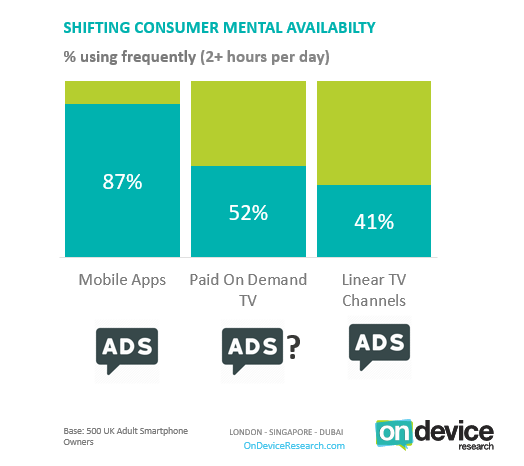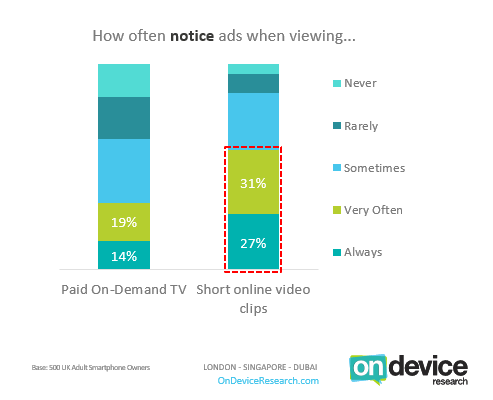On Device Research has today released findings from the latest wave of its [Path to Purchase tracker](https://ondeviceresearch.com/document/340) which show that after convenience, ad fatigue plays a big role in driving paid On-Demand TV usage in the UK.
Over two in five respondents say that seeing fewer ads than they do watching linear TV motivates paid On-Demand TV viewing, with significant implications for brand advertisers and On-Demand TV providers alike.
The rise of paid On Demand TV services is a now well-established fact of the digital economy with 52% of smartphone owners now watching it regularly, vs 42% for linear TV channels. Netflix reported a global subscriber base of 104 million worldwide as of July 2017 and while both Netflix and Amazon are seeing huge increases in usage, neither show third party ads. With consumer eyeballs not doing what they used to, the decision on where to allocate brand ad budget is more important than ever before.

In the online world, over 20% of users block ads. However, offline ad avoidance is less simple, and it is for this reason that for 41% of respondents, the relative lack of ads in paid On-Demand TV compared to linear TV is driving usage.
As the chart below shows, ads are also far more readily noticed in short online video clips (i.e. on Youtube, or embedded short form video content on other websites) than in paid On-Demand TV, with 58% noticing them “always” or “very often” versus a third with On-Demand.

The platforms commanding consumer attention are the platforms that marketers must employ to maximise brand exposure, yet at the same time they must be careful to produce ads that resonate not irritate. Ad measurement becomes all-the-more important in the cluttered digital world and increasingly advertisers must take a holistic cross-platform view of digital campaign impact. With half of tracker respondents claiming to have controlled their TV using a smartphone through a service like Google Chromecast in the last three months, extending digital campaign measurement to the TV set creates such a cross-platform opportunity.
On-Demand is on the rise and advertisers must put the building blocks in place to assess digital ad effectiveness and fully capitalise on the On-Demand opportunity.
On Device Research’s Path to Purchase tracker is a bi-annual, multi-country study that takes in the views of 500 smartphone users per market, unearthing insight in to the role of mobile, app, online video and emerging digital media in the consumer purchase journey. If you’d like to download a copy of this report click here.
If you’d like to find out more about the Path to Purchase Tracker or how to measure digital campaign performance, then get in touch with On Device Research today: info@ondeviceresearch.com / +44(0)20 7278 6627 / https://ondeviceresearch.com/cross-device-brand-impact
